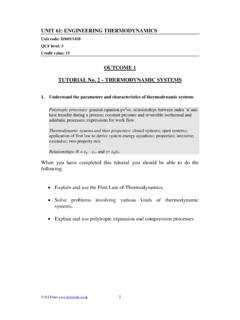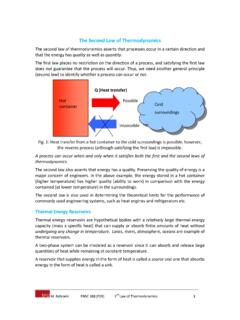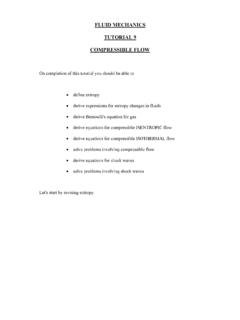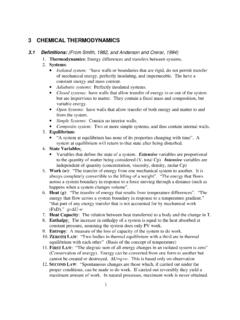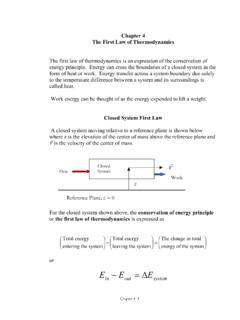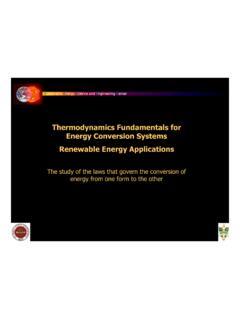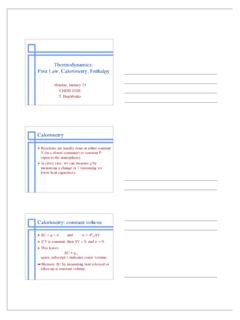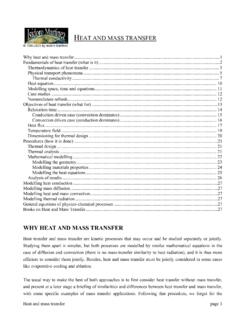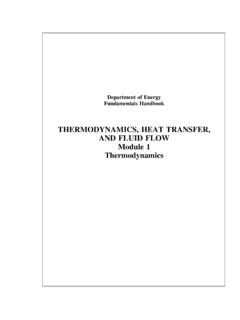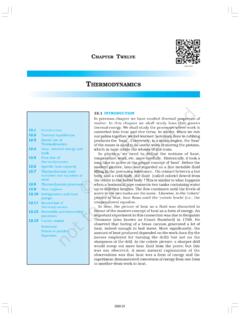Transcription of THERMODYNAMICS
1 CHEMISTRY154 THERMODYNAMICSIt is the only physical theory of universal content concerningwhich I am convinced that, within the framework of theapplicability of its basic concepts, it will never be EinsteinAfter studying this Unit, you willbe able to explain the terms : system andsurroundings; discriminate between close,open and isolated systems; explain internal energy, workand heat; state first law ofthermodynamics and expressit mathematically; calculate energy changes aswork and heat contributionsin chemical systems; explain state functions: U, H.
2 Correlate DU and DH; measure experimentally DUand DH; define standard states for DH; calculate enthalpy changes forvarious types of reactions; state and apply Hess s law ofconstant heat summation; differentiate between extensiveand intensive properties; define spontaneous and non-spontaneous processes; explain entropy as athermodynamic state functionand apply it for spontaneity; explain Gibbs energy change(DG); establish relationship betweenDG and spontaneity, DG andequilibrium energy stored by molecules can be released as heatduring chemical reactions when a fuel like methane, cookinggas or coal burns in air.
3 The chemical energy may also beused to do mechanical work when a fuel burns in an engineor to provide electrical energy through a galvanic cell likedry cell. Thus, various forms of energy are interrelated andunder certain conditions, these may be transformed fromone form into another. The study of these energytransformations forms the subject matter of laws of THERMODYNAMICS deal with energy changes ofmacroscopic systems involving a large number of moleculesrather than microscopic systems containing a few is not concerned about how and at whatrate these energy transformations are carried out, but isbased on initial and final states of a system undergoing thechange.
4 Laws of THERMODYNAMICS apply only when a systemis in equilibrium or moves from one equilibrium state toanother equilibrium state. Macroscopic properties likepressure and temperature do not change with time for asystem in equilibrium state. In this unit, we would like toanswer some of the important questions throughthermodynamics, like:How do we determine the energy changes involved in achemical reaction/process? Will it occur or not?What drives a chemical reaction/process?To what extent do the chemical reactions proceed?
5 UNIT 6 NCERTnot to be republishedTHERMODYNAMICS THERMODYNAMIC TERMSWe are interested in chemical reactions and theenergy changes accompanying them. For thiswe need to know certain thermodynamicterms. These are discussed system and the SurroundingsA system in THERMODYNAMICS refers to thatpart of universe in which observations aremade and remaining universe constitutes thesurroundings. The surroundings includeeverything other than the system . system andthe surroundings together constitute theuniverse.
6 The universe = The system + The surroundingsHowever, the entire universe other thanthe system is not affected by the changestaking place in the system . Therefore, forall practical purposes, the surroundingsare that portion of the remaining universewhich can interact with the , the region of space in theneighbourhood of the system constitutesits example, if we are studying thereaction between two substances A and Bkept in a beaker, the beaker containing thereaction mixture is the system and the roomwhere the beaker is kept is the surroundings(Fig.)
7 Be real or imaginary. The wall that separatesthe system from the surroundings is calledboundary. This is designed to allow us tocontrol and keep track of all movements ofmatter and energy in or out of the Types of the SystemWe, further classify the systems according tothe movements of matter and energy in or outof the Open SystemIn an open system , there is exchange of energyand matter between system and surroundings[Fig. (a)]. The presence of reactants in anopen beaker is an example of an open system *.Here the boundary is an imaginary surfaceenclosing the beaker and closed SystemIn a closed system , there is no exchange ofmatter, but exchange of energy is possiblebetween system and the surroundings[Fig.]
8 (b)]. The presence of reactants in aclosed vessel made of conducting material ,copper or steel is an example of a Open, closed and isolated system and the surroundingsNote that the system may be defined byphysical boundaries, like beaker or test tube,or the system may simply be defined by a setof Cartesian coordinates specifying aparticular volume in space. It is necessary tothink of the system as separated from thesurroundings by some sort of wall which may* We could have chosen only the reactants as system then walls of the beakers will act as boundary.
9 NCERTnot to be republishedCHEMISTRY1563. Isolated SystemIn an isolated system , there is no exchange ofenergy or matter between the system and thesurroundings [Fig. (c)]. The presence ofreactants in a thermos flask or any other closedinsulated vessel is an example of an State of the SystemThe system must be described in order to makeany useful calculations by specifyingquantitatively each of the properties such asits pressure (p), volume (V), and temperature(T ) as well as the composition of the need to describe the system by specifyingit before and after the change.
10 You would recallfrom your Physics course that the state of asystem in mechanics is completely specified ata given instant of time, by the position andvelocity of each mass point of the system . Inthermodynamics, a different and much simplerconcept of the state of a system is does not need detailed knowledge of motionof each particle because, we deal with averagemeasurable properties of the system . We specifythe state of the system by state functions orstate state of a thermodynamic system isdescribed by its measurable or macroscopic(bulk) properties.










